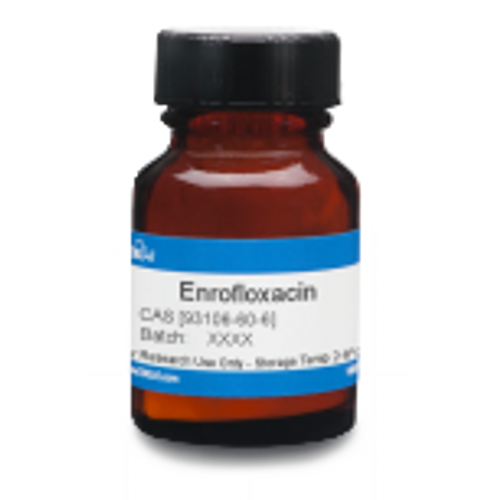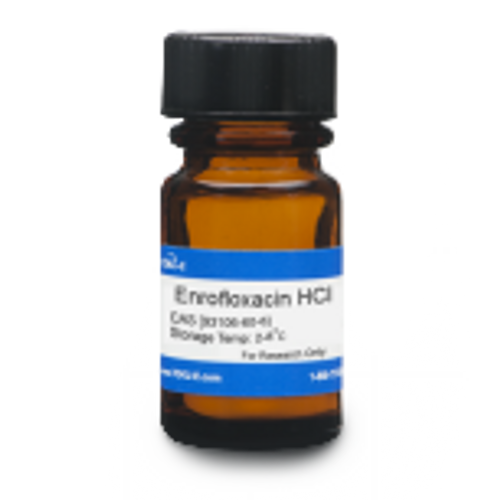Enrofloxacin is a fluoroquinolone synthetic antibiotic and quinolone carboxylic acid derivative, belonging to the 6-fluoro-7-piperazinyl-4-quinolones. A broad-spectrum antibiotic, it targets Gram-positive and Gram-negative bacteria along with a few Mycoplasma species. It is a chemotherapeutic, and was first synthesized in 1983 from nalidixic acid, and the first enrofloxacin-based therapeutic compound landed on the market in 1991 as an oral formulation for poultry under the trade name Baytril® (Bayer). It can be used to investigate bacterial genetics and study the mode of action of fluoroquinolones.
Enrofloxcin is slightly soluble in aqueous solution.
We also offer:
- Enrofloxacin Hydrochloride (E007)
| Mechanism of Action | Fluoroquinolone antibiotics target bacterial DNA gyrase, an enzyme which reduces DNA strain during replication. Because DNA gyrase is required during DNA replication, subsequent DNA synthesis and ultimately cell division is inhibited. |
| Spectrum | Enrofloxacin is a broad-spectrum antibiotic targeting a wide variety of Gram-positive and Gram- negative bacteria and a few Mycoplasma species. |
| Impurity Profile | Impurity A| 7-chloro-1-cyclopropyl-6-fluoro-4-oxo-1,4-dihydroquinoline-3-carboxylic acid|||| Impurity B| ciprofloxacin|||| Impurity C| 1-cyclopropyl-7-(4-ethylpiperazin-1-yl)-4-oxo-1,4-dihydroquinoline-3-carboxylic acid|||| Impurity E| 6-chloro-1-cyclopropyl-7-(4-ethylpiperazin-1-yl)-4-oxo-1,4-dihydroquinoline-3-carboxylic acid|||| Impurity F| 1-cyclopropyl-7-(4-ethylpiperazin-1-yl)-6-fluoroquinolin-4(1H)-one|||| Impurity G| 7-[(2-aminoethyl)amino]-1-cyclopropyl-6-fluoro-4-oxo-1,4-dihydroquinoline-3-carboxylic acid|||| |
| Microbiology Applications | Enrofloxacin is commonly used in clinical in vitro microbiological antimicrobial susceptibility tests (panels, discs, and MIC strips) against gram positive, gram negative, and certain Mycoplasma species. Medical microbiologists use AST results to recommend antibiotic treatment options. Representative MIC values include:
Enrofloxacin monitoring using surface-enhanced Raman scattering (SERS) is a technique that can be used to detect trace amounts of antibiotics in the environment. Polyethylene microplastics (PE MPS) were used to concentrate the enrofloxacin in water. SERS peaks can be observed from the spectra of the extracts eluted from MPS . The technique was used in real river water, with minimal detection of 1O-10 M for enrofloxacin. The technique was also used for Ciprofloxacin Hydrochloride monohydrate and Triclosan in water, with detection of 10-8M for both (Shan et al, 2023). The development of resistance is caused by resistance genes (qnr), presence of efflux pumps, presence of an enzyme (acetyltransferase AAC (6')lb-cr that can modify thuoroquinolones, or due to mutations in the quinolone resistance determinant region (QRDR) in the subunits forming topoisomerases II, IV (Piddock, 1999). It resistance to one fluoroquinolone usually means that the bacterial cells are insensitive to other antibiotics from this group due to the fluoroquinolone backbone. The presence of Enrofloxacin in aquatic environments, the primary sites of acccumulation are in surface waters. The largest reservoirs are in domestic, municipal and hospital wastewaters where concentration can be as high as 100 µg/L (Babic et al, 2013). Enrofloxacin can interact with metal ions and laboratory diagnostics can make use of this phenomenon. Tong et al. was able to detect Enrofloxacin in pharmaceutical preparations and milk using a fluoresence method based on yttrium-induced luminescense (Tong et al, 2010). |
| Molecular Formula | C19H22FN3O3 |
| References |
Babic S, Perisa M and Skoric (2013) Photolytic Degradation of Norfloxacin, Enrofloxacin and Ciprofloxacin in Various Aqueous Media. Chemosphere 91:1635–1642 Tong C, Zhuo X, Liu W, Wu J (2010) Synchronous fluorescence measurement of Enrofloxacin in the pharmaceutical formulation and its residue in milks based on the yttrium (III)-perturbed luminescence Grabowski L et al (2022) Enrofloxacin- The ruthless killer of eukaryotic cells or the last hope in the fight against bacterial infections? Int. J. Molec. Sci. 23:3648 Piddock LJV (1999) Mechanisms of fluoroquinolone resistance: An apdate 1994–1998. Drugs 58 (Suppl 2):11–18 Prescott JF and Yielding KM (1990) In vitro susceptibility of selected veterinary bacterial pathogens to ciprofloxacin, Enrofloxacin and norfloxacin. Can. J. Vet. Res. 54(1):195-197 PMID 2306672 Schroder (1989) Enrofloxacin: A new antimicrobial agent. J S Afr Vet Assoc 60(2):122-124 PMID 2691696 Shan J, Ren T, Li X, Jin M, and Wang X (2023) Study of microplastics as sorbents for rapid detection of multiple antibiotics in water based on SERS technology. Spectrochimica Acta Part A: Molec. and Biomolec. Spectroscopy. 284:121779 ISSN 1386-1425 Wolfson JS and Hooper DC (1985) The fluoroquinolones: Structures, mechanisms of action and resistance, and spectra of activity in vitro." Am. Soc. for Microbiol. 4th ser. 28:581-86 |
| MIC | Aeromonas hydrophila| 0.06 - >0.4 || Aeromonas salmonicida subsp. salmonicida| 0.0047 - 0.06 || Burkholderia mallei| 2 - 4|| Enterococcus| 0.5 - 8 || Enterococcus faecalis| 0.39 - 25 || Enterococcus faecium| 0.05 - 12.5 || Enterococcus hirae| 0.2 - 6.25 || Escherichia coli| 0.008 - 512 || Haemophilus parasuis| 0.12 - 8 || Lactobacillus acidophilus| 16 - 128 || Lactobacillus buchneri | 8 - 16|| Lactobacillus plantarum| 0.125 - 16 || Lactobacillus reuteri| 4 - 32|| Lactobacillus rhamnosus| 4 - 8|| Lactobacillus salivarius | 4 - 16|| Lactococcus | 0.5 - 8 || Leuconostoc | 0.5 - 8 || Mannheimia haemolytica| 0.007 - 0.125 || Mycoplasma bovis| 0.06 - 2 || Mycoplasma fermentans| <0.49 || Mycoplasma gallisepticum| 0.01 - >32 || Mycoplasma hyopneumoniae| 0.015 - >1 || Mycoplasma hyorhinis| 1.95|| Mycoplasma hyosynoviae| 0.05 - 0.5 || Mycoplasma iowae| 0.03 - 1 || Mycoplasma meleagridis| 0.015 - 3.13 || Mycoplasma synoviae | 0.025 - >32 || Pasteurella haemolytica| 0.03|| Pasteurella multocida| 0.00375 - 0.125 || Pediococcus | 0.5 - 8 || Pseudomonas aeruginosa| 0.5 - 2 || Rhodococcus equi| 0.03 - >4 || Salmonella typhimurium| 0.03|| Staphylococcus| ≤0.25 - 2 || Staphylococcus aureus| 0.0925 - 64 || Staphylococcus intermedius| 0.03 - 0.25 || Streptococcus bovis| 1 - 16|| Streptococcus infantarius | 1 - 16|| Weissella spp.| 1 - 16|| |




